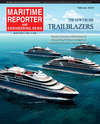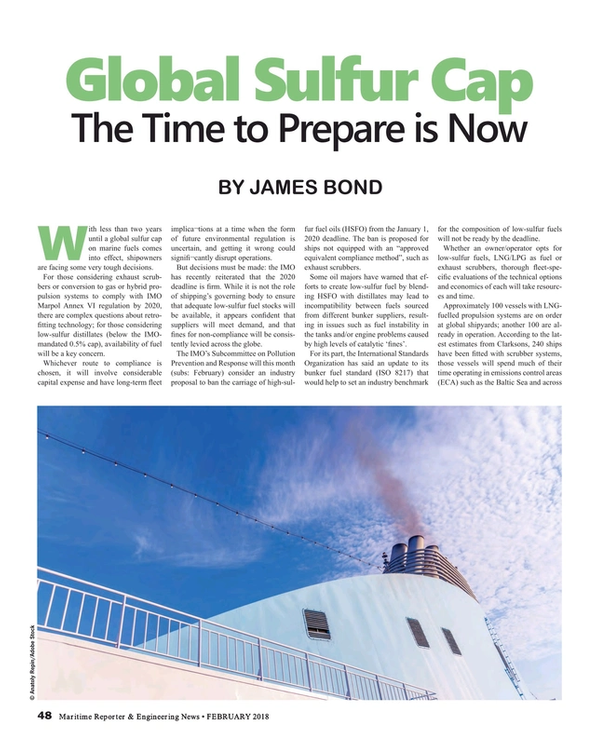
Global Sulfur Cap: Maritime Must Prepare Now
By James Bond, ABS Advisory Services
With less than two years until a global sulfur cap on marine fuels comes into effect, shipowners are facing some very tough decisions.
For those considering exhaust scrubbers or conversion to gas or hybrid propulsion systems to comply with IMO Marpol Annex VI regulation by 2020, there are complex questions about retrofitting technology; for those considering low-sulfur distillates (below the IMO-mandated 0.5% cap), availability of fuel will be a key concern.
Whichever route to compliance is chosen, it will involve considerable capital expense and have long-term fleet implica¬tions at a time when the form of future environmental regulation is uncertain, and getting it wrong could signifi¬cantly disrupt operations.
But decisions must be made: the IMO has recently reiterated that the 2020 deadline is firm. While it is not the role of shipping’s governing body to ensure that adequate low-sulfur fuel stocks will be available, it appears confident that suppliers will meet demand, and that fines for non-compliance will be consistently levied across the globe.
The IMO’s Subcommittee on Pollution Prevention and Response will this month (subs: February) consider an industry proposal to ban the carriage of high-sulfur fuel oils (HSFO) from the January 1, 2020 deadline. The ban is proposed for ships not equipped with an “approved equivalent compliance method”, such as exhaust scrubbers.
Some oil majors have warned that efforts to create low-sulfur fuel by blending HSFO with distillates may lead to incompatibility between fuels sourced from different bunker suppliers, resulting in issues such as fuel instability in the tanks and/or engine problems caused by high levels of catalytic ‘fines’.
For its part, the International Standards Organization has said an update to its bunker fuel standard (ISO 8217) that would help to set an industry benchmark for the composition of low-sulfur fuels will not be ready by the deadline.
Whether an owner/operator opts for low-sulfur fuels, LNG/LPG as fuel or exhaust scrubbers, thorough fleet-specific evaluations of the technical options and economics of each will take resources and time.
Approximately 100 vessels with LNG-fuelled propulsion systems are on order at global shipyards; another 100 are already in operation. According to the latest estimates from Clarksons, 240 ships have been fitted with scrubber systems, those vessels will spend much of their time operating in emissions control areas (ECA) such as the Baltic Sea and across the coastal North America where fuel-sulfur limits have been set to 0.10%.
The type of scrubber (wet, dry, or hybrid) that best suites a specific ship will largely depend on the marine and regulatory environments in its selected area of operations.
For example, if the ship has an operating profile with minimum transit times through ECAs, or where there are no restrictions on the discharge water by local or regional authorities, an open loop scrubber may suffice. If it has long port stays with an appreciable time in ECAs, a hybrid or closed-loop scrubber system may be the best option.
The cost of scrubber systems includes the price of the scrubber, installation expenses, any additional miscellaneous auxiliary equipment, off hire, ship modifications, any fuel consump¬tion required to operate the system and the cost of consumables (for example, cleaners such as sodium hydroxide). These elements are used to form a cost-comparison against the expense operating the ship’s fuel combustion units on low-sulfur fuel, for example.
For ships under construction that intend to operate inside an ECA, an already complex situation is compounded by the requirements of the IMO’s Tier III NOx emissions regulation. A main engine that is Tier-III compliant (e.g., some engines operating in gas mode) will be needed, or the vessels’ propulsion units will need to be designed with NOx abatement tech¬nology such as exhaust gas recirculation or selective catalytic reduction systems.
While the proportion of new ships being ordered with scrubbers is on the rise (from roughly 1% through 2012-15 to about 5% last year), present uptake levels combined with the number of ordered and existing gas-fuelled ships appears to indicate that most of the estimated 70,000 ships subject to the global cap will opt for low-sulfur fuel by the deadline.
With so many technical variables – and so much information available – it is important for owners to take a structured approach to the decision-making process.
ABS believes that one of the keys to a cost-effective transition to low-sulfur shipping is an evaluation process that examines the available technology, its appropriateness for the intended theatre of operations and economic considerations such as life-cycle costs, comparative savings against other products and solutions, payback period and rate of return on investment.
The ABS Techno-Economic Evaluation considers ship design, equipment details, trading routes, fuel cost trends and fleet analysis to establish a base trading case and alternative technology and fuel scenarios. This information supports meaningful comparisons between options and arrival at a preferred solution for retrofitting or new construction projects.
The evaluation’s life-cycle approach provides a clear evaluation of the cost differentials by using a comprehensive inventory of projects and operational costs in terms of present value. Newbuild and retrofit technology decisions can be simulated for a single vessel or a series of vessels using a range of scenarios that investigate compliance requirements.
Beyond techno-economic modelling, ABS has published guidance for the steps owners should take to install exhaust-gas scrubbers, as well as an advisory to highlight what owner/operators need to know about the 2020 sulfur cap.
For those owners intent on ordering vessels but hoping for more clarity on issues such as fuel supply and quality standards before choosing their fleet’s path to com¬pliance, ABS has ‘LNG or Scrubber ready’ notations, which allows them to prepare vessels for implementing LNG or scrubber options at a later date.
A sulfur cap on marine fuels is now less than two years away and the industry’s response will define the shape of cleaner ships for the near term. The path to compliance may become clearer in the coming months for each ship, but it is a journey the international shipping community has to take.
The Author:
Based in Houston, Texas, James Bond is a Senior Technical Advisor for the American Bureau of Shipping’s Global Engineering and Technology group. James has worked in the marine and offshore industries for 30+ years, primarily in the fields of structural design and analysis.
He has a Master of Engineering from Carleton University (Ottawa) and a Bachelor of Applied Science in Engineering from the University of Waterloo. He is a registered Professional Engineer in Ontario and a member of the Society of Naval Architects and Marine Engineers.
As published in the February 2018 edition of Maritime Reporter & Engineering News: https://magazines.marinelink.com/nwm/MaritimeReporter/201802/
Read Global Sulfur Cap: Maritime Must Prepare Now in Pdf, Flash or Html5 edition of February 2018 Maritime Reporter
Other stories from February 2018 issue
Content
- Analysis: Government Proposal 'Ill-informed' on Maritime Matters page: 10
- Maritime & Strict Liability Criminal Statutes page: 12
- Tugboats & Vessel Response Plans page: 12
- Data is the New Oil and Satellites Are the Pipeline page: 22
- New Research in Biofilms: Fighting Nature with Nature page: 24
- How Much is That Superyacht Worth? page: 28
- Adventure Bound: Sunstone Ships Climbs to New Heights page: 32
- Luxury Cruise Ships & The French Connection page: 38
- Cruise Ships & Eco-Trends in Energy Transition page: 44
- Global Sulfur Cap: Maritime Must Prepare Now page: 48
- Volvo Ocean Race: Zero Emission Shipping Meets High-Level Sports page: 50
- Eco Ships: The New Norm for Top Tier Ships page: 52
- Krilo Jesenice: Village of the Cruisers page: 60
- Tech File: Fuel Monitoring Matters page: 66


